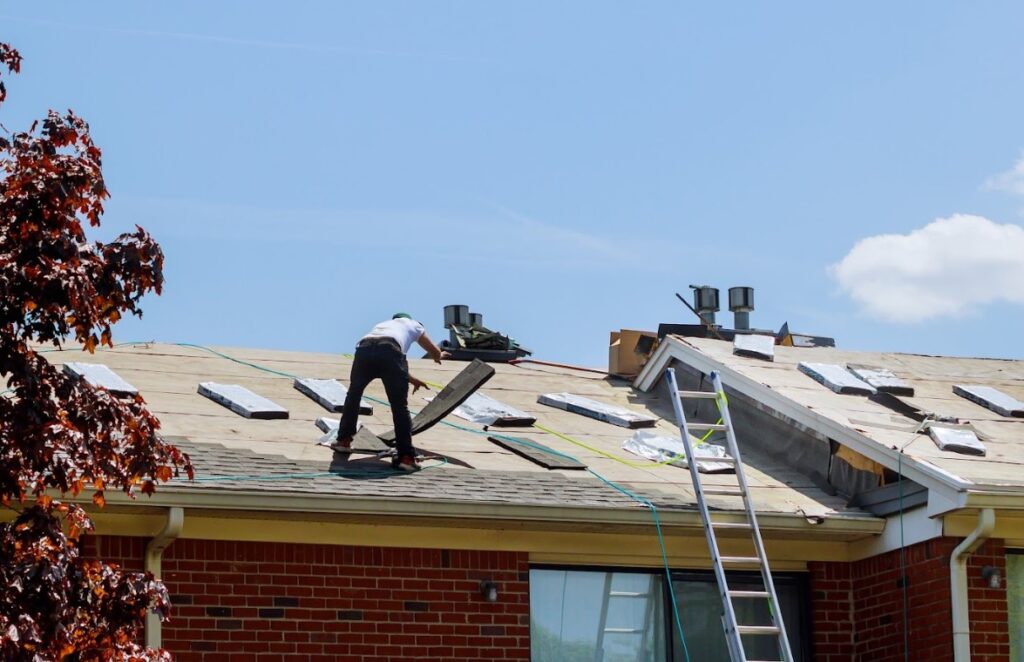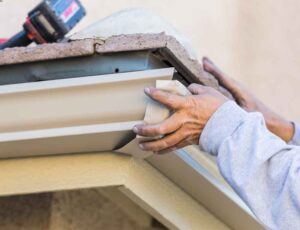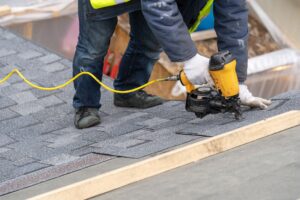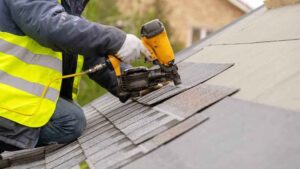If you’ve lived in Indiana for more than a few seasons, you know the weather doesn’t play by the rules. One day it’s sunny and 70, the next your driveway’s covered in sleet. This unpredictability raises one of the most common questions we hear at Cornett Roofing Systems:
What is the best temperature to replace a roof?
The answer isn’t just about convenience—it impacts installation quality, material performance, and long-term durability. Timing your project for the best temperature for roof replacement is one of the smartest decisions a homeowner can make.
This guide walks you through when, why, and how to plan your roof replacement based on Indiana’s seasonal conditions, common misconceptions, and material-specific needs.
In This Article, You’ll Learn:
- The ideal temperatures for installing different roofing materials
- Why cold or hot weather can lead to roofing failures
- Common timing myths that trip up homeowners
- DIY vs. pro installation by season
- Why Cornett Roofing installs permanent roofs year-round
For expert guidance or to schedule an inspection, visit Cornett Roofing Systems.
Why Temperature Matters for Roof Replacement in Indiana
Indiana’s climate includes bitter cold, high winds, summer humidity, and everything in between. These conditions can seriously affect how roofing materials behave—both during and after installation.
If you don’t install roofs at the proper temperatures, you might run into some of the following issues:
Thermal Activation Failure
Many asphalt shingles rely on a thermal-activated adhesive strip to bond the shingles together. This seal forms when temperatures stay consistently above 45°F for at least 24–48 hours, ideally in sunny conditions. When installed in colder temperatures without artificial warming methods, these adhesives may never properly activate, which leaves the shingles vulnerable to:
- Wind uplift during storms (even 60 mph winds can dislodge unsealed shingles)
- Water intrusion during freeze-thaw cycles
- Shortened roofing lifespan by up to 40% in some cases
We’ve seen roofs installed in late November fail by the following spring—not because of bad shingles, but because they never sealed.
Cold Cracking
Shingles, synthetic tiles, and even natural slates become more brittle as the temperature drops. Below 40°F, standard asphalt shingles are much more prone to cracking when nailed, especially if stored outside before installation. Cracking leads to:
- Compromised water protection
- Visible fractures or splits within the first few weeks
- Void warranties from manufacturers if installed outside approved temperature ranges
This is especially critical for synthetic slate and tile, where improper handling or pressure can cause edge chips or corner breaks that aren’t always visible at first—but can widen over time, letting moisture in.
Expansion Gap Errors
Metal roofs are among the most durable roofing systems, but they are highly temperature-responsive. Metal expands in heat and contracts in cold, meaning proper installation must account for:
- Expansion spacing between panels
- Floating fasteners or clips (vs. fixed)
- Substrate conditions that allow movement
When improperly installed in fluctuating weather—or when fasteners are overdriven in cold—metal roofs can buckle, warp, or develop oil-canning. These aren’t just cosmetic issues. They can compromise waterproofing, damage fasteners, and reduce energy efficiency by allowing gaps in insulation.
Even a ¼ inch mistake per panel across a large surface can lead to structural stress, sheathing damage, and premature roof failure.
What to Know Before You Schedule Your Roof Replacement
Roofing isn’t just about the materials—it’s also about planning. Here’s what every homeowner should know before moving forward.
| Step | What to Do |
| Budget | Set a realistic range and ask about financing options. Cornett offers flexible plans. |
| Material | Choose based on longevity, style, and seasonality. Some materials are more weather-sensitive. |
| Permits | Most Indiana counties require a permit. Cornett Roofing will handle this for you. |
| Timing | Avoid waiting for leaks—proactive scheduling saves money and damage. |
| Contractor | Not all roofers install year-round. We do, using manufacturer-approved methods. |
What Is the Best Temperature to Replace a Roof?
Ideal Temperature Ranges by Roofing Material
| Material | Best Install Temperature | Cold Weather Risks | Hot Weather Risks |
| Asphalt Shingles | 45°F–85°F | Won’t seal properly | Sealant may over-soften |
| Metal Roofing | 35°F–100°F | Shrinkage or fastener stress | Expansion without proper spacing |
| Synthetic Slate or Tile | 40°F–80°F | Cracking or chipping | Fragility under pressure |
| Flat Roofing (TPO/EPDM) | 50°F–90°F | Adhesive won’t cure | Cures too quickly, bubbles form |
Best Seasons for Indiana Roof Replacement
- Spring (April–May): Mild temperatures and fewer rain delays
- Fall (September–October): Cool, dry conditions ideal for most materials
- Winter: Installation is possible with metal or synthetic materials, but asphalt requires special handling
- Summer: Viable for most systems, but extreme heat requires earlier start times and extra care
Cornett Roofing Systems installs all roof types year-round, using correct procedures for temperature-sensitive materials.

Why Roofing in the Wrong Temperature Fails
All of these risks—whether it’s adhesives not sealing, shingles cracking, or metal warping—come down to one core truth: roofing installed in the wrong conditions will fail faster. And those failures don’t take years to show up; they can happen within weeks or the very next storm.
Some of the most common problems we see from poorly timed installations include:
- Lifting shingles due to unsealed adhesive in cold weather
- Cracked tiles or shingles from brittle materials installed below 40°F
- Metal distortion from poor spacing for expansion and contraction
- Voided warranties when manufacturers’ temperature guidelines are ignored
We’ve seen this play out in real life. A homeowner near Columbus, Indiana chose a budget contractor who installed asphalt shingles in January. By April, shingles were lifting across the roof, water had begun leaking into the attic, and the warranty was void.
Cornett Roofing replaced the failing system with an in-house manufactured standing-seam metal roof—and that roof hasn’t had an issue since.
What Homeowners Often Get Wrong About Timing
Misinformation can cost you more than just time—it can lead to early roof failure, unexpected repairs, and wasted money. Here are three of the most common timing myths we correct during inspections and consultations.
Myth: You can’t replace a roof in winter.
You can—if you’re using materials like metal, synthetic slate, or tile, and you’re working with an experienced contractor. Proper tools and installation techniques make winter installs safe and effective.
Myth: Summer is always ideal.
Not if temperatures rise above 90°F. In extreme heat, sealants can cure too quickly or become too soft, leading to uneven sealing and compromised durability.
Myth: I’ll wait until I see damage.
By the time leaks are visible or water stains appear, you may already have rotted decking, insulation damage, or mold. Roofs should be inspected and replaced before damage becomes apparent.
Working with an experienced contractor helps avoid the pitfalls of poor timing—no matter the season.
Local Weather Resources for Roof Planning
Planning your project around regional climate trends is smart. These resources can help:
- Indiana State Climate Office: Temperature history and weather maps
- NOAA 30-Year Climate Normals: Long-term seasonal patterns
Cornett Roofing can also help you select the best time based on local forecasts and crew availability.
Community-Driven, Seasonally Smart Roofing
Cornett Roofing Systems has installed permanent roofing systems across Indiana since 1991. We’re committed to building roofs that perform through every season, not just the easy ones.
We also give back through our Cornett Cares program, which includes:
- Donated roofs for youth league dugouts
- Community food drives
- Promoting sustainability with long-lasting materials that reduce landfill waste
When we say we’re local—we mean it. We live here, too.
Ready to upgrade your roof with a company that builds for all seasons and supports the local community? Schedule your free inspection today
Quick Takeaways
- The best temperature for roof replacement in Indiana is 45°F to 85°F.
- Spring and fall are the best seasons for consistent, safe installation.
- Winter installs are possible with the right materials and professional crews.
- Heat and cold can both cause premature failure if the install is not handled correctly.
- Cornett Roofing installs permanent roofing systems year-round across Indiana and the Midwest.
Common Questions About Roof Replacement in Indiana
What is the best temperature to replace a roof in Indiana?
The best temperature to replace a roof in Indiana is ideally between 45°F and 85°F. Spring and fall typically offer the most consistent and reliable weather conditions for installation.
Can I replace a roof in winter?
Yes, you can replace a roof in winter, especially if you’re using materials like metal, tile, or synthetic slate. Asphalt shingles may still be used, but they require warm temperatures or specialized adhesives to seal correctly.
What happens if my roof is installed in freezing weather?
If your roof is installed in freezing weather, shingles may not seal properly, tiles can crack during installation, and your warranty may be voided due to improper application conditions.
Do I need a permit to replace my roof in Indiana?
Yes, you need a permit to replace your roof in most Indiana counties. Cornett Roofing Systems handles all permitting on behalf of our clients to ensure compliance with local codes.
What type of roof lasts the longest in Indiana?
The type of roof that lasts the longest in Indiana is metal or synthetic slate, which typically offers 50 years or more of performance. These materials outperform traditional asphalt shingles in both durability and longevity.
How long does a roof replacement take?
A typical roof replacement in Indiana takes one to three days for most residential homes, depending on the size of the roof, complexity of the job, and weather conditions.
Does Cornett Roofing install roofs year-round?
Yes, Cornett Roofing installs roofs year-round. We’ve worked in all seasons for over 30 years, using temperature-appropriate materials and proven installation techniques.
Choosing the Right Time — and the Right Roofing Partner in Indiana
Knowing what is the best temperature to replace a roof gives you a head start—but choosing the right contractor matters even more. With 33 years of experience, in-house product manufacturing, and a track record of high-quality installations in all seasons, Cornett Roofing Systems is the name Indiana homeowners trust.
We’re not just building roofs—we’re building peace of mind, backed by warranties that protect your investment.
Schedule your free roof inspection today with Cornett Roofing Systems, and let’s find the best time—and the best system—for your home.





